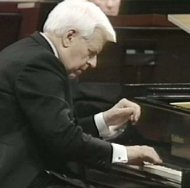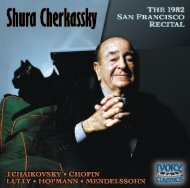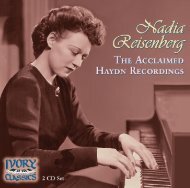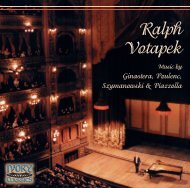The Well-Tempered Clavier, Book 2 - Ivory Classics
The Well-Tempered Clavier, Book 2 - Ivory Classics
The Well-Tempered Clavier, Book 2 - Ivory Classics
Create successful ePaper yourself
Turn your PDF publications into a flip-book with our unique Google optimized e-Paper software.
Albert Wong<br />
PRODIGY<br />
10 YEAR OLD<br />
<strong>The</strong> <strong>Well</strong>-<strong>Tempered</strong><br />
<strong>Clavier</strong> <strong>Book</strong> 2<br />
(Complete)<br />
2 CD Set
1<br />
2<br />
3<br />
4<br />
5<br />
6<br />
7<br />
8<br />
9<br />
10<br />
11<br />
12<br />
13<br />
14<br />
15<br />
16<br />
17<br />
18<br />
19<br />
20<br />
21<br />
22<br />
23<br />
24<br />
❖ Albert Wong • <strong>The</strong> <strong>Well</strong>-<strong>Tempered</strong> <strong>Clavier</strong>, <strong>Book</strong> 2 ❖<br />
Preludes and Fugues Nos. 1-12 – DISC 1<br />
Prelude No.1 in C Major, BWV 870 2:42<br />
Fugue No.1 in C Major, BWV 870 1:33<br />
Prelude No.2 in C minor, BWV 871 1:34<br />
Fugue No.2 in C minor, BWV 871 1:58<br />
Prelude No.3 in C sharp Major, BWV 872 2:04<br />
Fugue No.3 in C sharp Major, BWV 872 1:44<br />
Prelude No.4 in C sharp minor, BWV 873 4:37<br />
Fugue No.4 in C sharp minor, BWV 873 2:26<br />
Prelude No.5 in D Major, BWV 874 3:40<br />
Fugue No.5 in D Major, BWV 874 3:04<br />
Prelude No.6 in D minor, BWV 875 1:38<br />
Fugue No.6 in D minor, BWV 875 1:56<br />
Prelude No.7 in E flat Major,BWV 876 2:13<br />
Fugue No.7 in E flat Major, BWV 876 1:54<br />
Prelude No.8 in E flat minor, BWV 877 3:10<br />
Fugue No.8 in E flat minor, BWV 877 3:06<br />
Prelude No.9 in E Major, BWV 878 3:25<br />
Fugue No.9 in E Major, BWV 878 2:39<br />
Prelude No.10 in E minor, BWV 879 3:21<br />
Fugue No.10 in E minor, BWV 879 2:59<br />
Prelude No.11 in F Major, BWV 880 3:18<br />
Fugue No.11 in F Major, BWV 880 1:45<br />
Prelude No.12 in F minor, BWV 881 3:24<br />
Fugue No.12 in F minor, BWV 881 2:08<br />
Total Playing Time: 64:14<br />
– 2 –
1<br />
2<br />
3<br />
4<br />
5<br />
6<br />
7<br />
8<br />
9<br />
10<br />
11<br />
12<br />
13<br />
14<br />
15<br />
15<br />
17<br />
18<br />
19<br />
20<br />
21<br />
22<br />
23<br />
24<br />
• Debut Recording •<br />
Preludes and Fugues Nos. 13-24 – DISC 2<br />
Prelude No.13 in F sharp Major, BWV 882 3:20<br />
Fugue No.13 in F sharp Major, BWV 882 2:48<br />
Prelude No.14 in F sharp minor, BWV 883 3:14<br />
Fugue No.14 in F sharp minor, BWV 883 3:30<br />
Prelude No.15 in G Major, BWV 884 1:34<br />
Fugue No.15 in G Major, BWV 884 1:17<br />
Prelude No.16 in G minor, BWV 885 2:41<br />
Fugue No.16 in G minor, BWV 885 2:48<br />
Prelude No.17 in A flat Major, BWV 886 4:10<br />
Fugue No.17 in A flat Major, BWV 886 2:25<br />
Prelude No.18 in G sharp minor, BWV 887 4:25<br />
Fugue No.18 in G sharp minor, BWV 887 4:06<br />
Prelude No.19 in A Major, BWV 888 1:29<br />
Fugue No.19 in A Major, BWV 888 1:29<br />
Prelude No.20 in A minor, BWV 889 2:35<br />
Fugue No.20 in A minor, BWV 889 1:55<br />
Prelude No.21 in B flat Major, BWV 890 4:00<br />
Fugue No.21 in B flat Major, BWV 890 2:08<br />
Prelude No.22 in B flat minor, BWV 891 2:57<br />
Fugue No.22 in B flat minor, BWV 891 4:54<br />
Prelude No.23 in B Major, BWV 892 2:40<br />
Fugue No.23 in B Major, BWV 892 3:11<br />
Prelude No.24 in B minor, BWV 893 2:22<br />
Fugue No.24 in B minor, BWV 893 1:40<br />
Total Playing Time: 69:35<br />
– 3 –
❖ Johann Sebastian Bach ❖<br />
by Albert Wong<br />
I have known Maestro Bach for six long years. Long enough for me to learn many of his<br />
famous compositions, but not long enough to write about him like a seasoned musicologist.<br />
I was four when I was first told that Bach was a great composer who lived a long time ago,<br />
and that he composed a vast number of keyboard, string, and vocal works. That was all I knew<br />
and cared to know about him for a while. A year later, I became curious about how this great<br />
man looked, so took a good look at some of his portraits. I found it was not hard at all to spot<br />
him among all of the other great composers, for he had a broad face, double chin, and a stern<br />
look, just like me. From that moment, I felt that I was very close to him, because I felt that<br />
we two must share certain thoughts. First, since he must have eaten a lot to nourish his double<br />
chin, he probably cherished good food the way I do. I simply can not do any serious work<br />
without having a full stomach! Second, because he did not smile when artists drew his portraits,<br />
he must have thought it was unnecessary, which is also the way I feel. Third, I so enjoy<br />
learning and playing all his piano compositions. He must have believed that a good piece of<br />
music can be played and interpreted in more than one way – which is what I believe too.<br />
Lastly, for reasons that simply can not be elucidated, I have always felt comfortable playing<br />
his works since I was a kid. (In case you haven’t noticed, I am a young man now! I turned ten<br />
years old on January 1, 2000).<br />
At age seven, I made my orchestral debut playing Bach’s F minor concerto. When I was<br />
eight, I learned his E major and D minor concertos. In every solo concert I play, I always<br />
begin with a Bach composition. For some abstruse reason, Bach always makes me feel secure.<br />
It is a mysterious power that has kept, and will continue to keep me close to this composer<br />
all of my life. When I was four, I learned to play Bach’s works the same way I learned all the<br />
other composer’s works. For the first year, Bach’s compositions were simply Baroque music to<br />
me, I played them purely by intuition. When I first began learning his two-part inventions at<br />
five, my teacher, Mr. Joseph Banowetz, taught me voicing, phrasing and the proper way of<br />
playing ornaments. Dr. Pamela Paul, has repeatedly stressed the importance of consciously<br />
removing myself from the piano and conducting all of the voices when I play Bach.<br />
Since I’m convinced that music played in a proper way is the guaranteed result of a systematic<br />
approach, I try very hard to add the elements of consciousness when I play. Now,<br />
when I pick up a new Fugue to learn, I will first take the score to my desk instead of the<br />
– 4 –
piano. I spend time searching and unveiling<br />
all the voices, counterpoint, and major and<br />
minor themes which maybe wrapped up in all<br />
sorts of disguises. <strong>The</strong>n I use the time to hear<br />
all the voices in my brain before I start to<br />
practice. Bach’s compositions are very clever<br />
in their own special way. Many of his compositions<br />
looked straight forward to me at first,<br />
but the more I thought about and played<br />
them, the harder they became, especially<br />
when trying to figure out the change of spirit,<br />
mood and personality of each voice. His<br />
Preludes and Fugues can easily sound like<br />
boring rondos with repeated themes. How to<br />
make them sound musical and interesting is a<br />
work of art. I simply cannot make a Bach<br />
Prelude or Fugue sound right without<br />
exhausting brain-work. It takes time and<br />
energy to understand them! A good composition,<br />
like a good painting, needs not only<br />
technique but also wisdom. It is the years of Johann Sebastian Bach<br />
accumulated wisdom, which make a good<br />
painting or composition stand out.<br />
Among all of Bach’s compositions, the <strong>Well</strong>-<strong>Tempered</strong> <strong>Clavier</strong>, commonly called the “48,”<br />
are some of the most complicated works he ever wrote. Some of them have as many as five<br />
voices occurring at the same time. <strong>The</strong>y are grouped into two books, consisting of 24 preludes<br />
and fugues each, labeled Part I and Part II. Part I was inspired by the wisdom of the J.C.F.<br />
Fischer Ariadne musica, from a set of 20 short preludes and fugues in a chromatic key order<br />
ascending from C to B. Bach finished Part II 20 years later, only a few years before his death.<br />
I feel very fortunate to be given this opportunity to make my debut recording with WTC<br />
<strong>Book</strong> II for <strong>Ivory</strong> <strong>Classics</strong>, since they were composed when Bach’s wisdom was at its apogee.<br />
Even though Bach has stated that this group of pieces were written as etudes for advanced<br />
students to practice, and to demonstrate that it was possible for all key signatures to be<br />
played in tune under this new equal-temperament tuning, I think that they mean much<br />
– 5 –
more than practicing or demonstrating<br />
pieces. <strong>The</strong>y are not only mercilessly complicated<br />
in their architecture, they are true art!<br />
You have to play them, think about them and<br />
sleep with them to uncover, enjoy and appreciate<br />
their beauty. When I approached the 24<br />
pieces in <strong>Book</strong> II, I found myself pondering<br />
over each one as they came thundering in, for<br />
each one had its own unique personality.<br />
Sometimes they looked similar but obviously<br />
they were quite distinct from each other.<br />
Although they required tiring brain work,<br />
they were not boring in the musical sense.<br />
I enjoyed his way of showing the grand, elegant,<br />
romantic, poetic, sorrowful, delightful<br />
dancing styles.<br />
It was a very challenging task to try to<br />
understand his whole life’s wisdom in the<br />
year that I learned these pieces. <strong>The</strong>re were<br />
many frustrating moments for me in these<br />
months! One afternoon, when I could not<br />
find the proper way to show the spirit of a<br />
Albert Wong age 3<br />
certain Fugue I was working on, the feeling<br />
of being stuck and defeated was terribly<br />
frustrating. I stormed into our bathroom and clogged the sink drain with a half box<br />
Kleenex tissues. <strong>Well</strong>, as you can imagine, I simply added another problem. My parents<br />
were not thrilled one bit – I was punished for showing my mood in a wrong way. My<br />
dinner was delayed for a least three hours that night! Patience, is what I have learned<br />
from my experience with these 24 monumental works. I had to constantly remind myself<br />
that it was OK if the first couple of tries did not work correctly. I needed to be patient<br />
practicing and searching for the right interpretations. After practicing all this patience, I<br />
would say that I have become an old soul who still does not have enough patience! What<br />
was the reward that came out of this hard work? Playing other composers’ works<br />
became more enjoyable and much easier than before! It was Maestro Bach<br />
– 6 –
who made me think and understand the patterns<br />
of all music.<br />
<strong>The</strong> general principles that I followed<br />
when I learned to perform these Bach compositions<br />
were really nothing new to me.<br />
Learning Physics made me realize that music<br />
works the same way. Newton’s laws, developed<br />
by the great physicist Isaac Newton<br />
(who lived around J.S. Bach’s time),<br />
quenched the people’s thirst for answers for<br />
more than a century. It was not until the 20 th<br />
century that people realized that Newton’s<br />
Laws work only when the bodies concerned<br />
are not too fast, too slow, too big, too small,<br />
too hot, or too cold. People who lived at that<br />
period of time simply could not perceive<br />
things that could not be sensed by our five<br />
senses. <strong>The</strong> peace and quietness of endless<br />
space dominated the world at that time.<br />
<strong>The</strong>re were no automobiles, no factories, and<br />
no pollution. Also, there was no need to rush<br />
for anything. That was the world in which<br />
Newton and Bach lived. This is why I believe Albert age 5<br />
that Bach’s music as well as most other<br />
Baroque composers’ music should be presented without extreme dynamics, elaborate phrases,<br />
and/or rubato. Not too fast, not too slow, not too big (elaborate), not too small (flat), not<br />
too hot (short), not too cold (long), not too loud, and not too soft are what I feel are the<br />
basics of playing Baroque music.<br />
However, we should always remember that music has to be musical no matter when or<br />
where it is being presented. Human beings simply cannot live without music. Why? Because<br />
music can greatly dictate people’s feelings and in order to enchant the listener’s heart, it should<br />
be musical! We need to hear some changes of dynamics, mood and spirit even in Baroque<br />
music. So my basic law is not to rush but to relax so that I bring out the true spirit of music<br />
to the best of my ability.<br />
– 7 –
❖ Bach’s <strong>Well</strong>-<strong>Tempered</strong> <strong>Clavier</strong> ❖<br />
<strong>The</strong> Preludes and Fugues were composed in two groups of twenty-four each. It was in<br />
1722, while he was at Cöthen, that Bach assembled <strong>Book</strong> I. In his full title, he tells us much<br />
about the nature and intention of the music:<br />
“<strong>The</strong> <strong>Well</strong>-<strong>Tempered</strong> <strong>Clavier</strong>, or Preludes and Fugues on every Tone and Semitone, with<br />
the major third Ut, Re, Mi, and the minor third Re, Mi, Fa. For the Use and Profit of Young<br />
Musicians eager to learn, and also as a Pastime for those already expert in this Art, set forth<br />
and composed by Johann Sebastian Bach, at presentation Capellmeister and Director of<br />
Chamber Music at the princely Court of Anhalt-Cöthen. Anno 1722.”<br />
Had Bach left us only this work, his immortality and his central position in the history of<br />
music would have been assured. After listening to it, one shares the reverence expressed by<br />
Robert Schumann in a letter written in 1840: “I myself make a daily confession of my sins to<br />
that mighty one, and endeavor to purify and strengthen myself through him... In fact, to my<br />
mind Bach is unapproachable – he is unfathomable.”<br />
<strong>Book</strong> II did not appear until twenty-two years later, in 1744 when Bach was Cantor of<br />
the St. Thomas Church in Leipzig. <strong>The</strong> new volume was designated simply as “Twenty-four<br />
new Preludes and Fugues.” <strong>The</strong> similarity of design between the two groups, separated by<br />
twenty two years, is undoubtedly responsible for their having been brought together under<br />
the one title.<br />
Paradoxically, this work, which was to inspire and influence more musicians perhaps than<br />
any other, was not published until fifty years after Bach’s death, although it had been circulated<br />
in manuscript copies among his students and others. <strong>The</strong> first printed editions which<br />
appeared in 1800-01 were issued by Nageli in Zurich, Simrock of Bonn and Paris, and<br />
Kuhnel of Leipzig. <strong>The</strong> first English editions date from 1810.<br />
In composing a Prelude and Fugue for each key, in the order of chromatic ascent, Bach<br />
glorified a new system of tuning, in which the keyboard instrument is tuned equally well for<br />
all keys. Hence, the term, well-tempered. Bach’s <strong>Well</strong>-<strong>Tempered</strong> <strong>Clavier</strong>, therefore, was an overwhelming<br />
demonstration of the importance of such a system of tuning to the composer.<br />
In putting together <strong>Book</strong> I, Bach incorporated music that he had composed earlier.<br />
Several of the Preludes exist in earlier, often simpler, versions than those in <strong>The</strong> <strong>Well</strong>-<br />
<strong>Tempered</strong> <strong>Clavier</strong>. In <strong>Book</strong> II, also, Bach used music written separately, sometimes transposing<br />
it to fit the key scheme. Prelude I of <strong>Book</strong> II, for instance, exists in three versions; and<br />
there is a charming Fughetta in G major (printed by Bischoff in the appendix of his edition)<br />
– 8 –
which served as the basis of the Fugue in G<br />
major, No. 15, of <strong>Book</strong> II.<br />
<strong>Book</strong> II differs from <strong>Book</strong> I in many<br />
respects. Frederick Ilffe, in his Analysis of<br />
Bach’s 48 Preludes and Fugues, points out that<br />
whereas in <strong>Book</strong> I “we find Bach speculating<br />
or making independent and original experiments<br />
in structure,... there is no direct influence<br />
of the Sonata type in the Preludes of this<br />
book; but in <strong>Book</strong> II we find, together with<br />
original and beautiful experiments... a goodly<br />
number of specimens of the old Sonata type.”<br />
<strong>The</strong> Preludes are every bit as fascinating as<br />
the Fugues and, in some ways, they point<br />
more clearly to later musical developments.<br />
Some of them are themselves fugal in character,<br />
such as Prelude 3 of <strong>Book</strong> II. Others are<br />
of the Invention type, such as Preludes 8, 10,<br />
and 20 of <strong>Book</strong> II. Others are of the fantasy<br />
type; still others resemble the arioso.<br />
Leichtentritt’s wonderful book, Musical Form,<br />
contains an interesting classification and<br />
analysis of the Preludes from this point of Albert age 5<br />
view. However they may be analyzed and dissected,<br />
each are glowing with beauty and inspiration. Bach is playful, reflective, passionate,<br />
mystical, boisterous, by turns, always surprising us with some new thought or fancy in his<br />
Preludes.<br />
Equally amazing is Bach’s range of design and expression in the Fugues. So free is he, in<br />
fact, that none of the fugues in <strong>The</strong> <strong>Well</strong>-<strong>Tempered</strong> <strong>Clavier</strong> obeys the strict laws of the textbooks<br />
written after him. Ralph Vaughan Williams has gleefully pointed out that one celebrated<br />
English teacher of counterpoint forbade his students to consult <strong>The</strong> <strong>Well</strong>-<strong>Tempered</strong><br />
<strong>Clavier</strong> because it did not obey the “rules”! Some of the fugues are dance-like (<strong>Book</strong> II, Nos.<br />
15, 21, and 24); others are pure song; and some lift us to such heights of nobility of tragic<br />
awareness that we are almost terrified by their power (<strong>Book</strong> II, Nos. 8, 9, 17, 20, 22, and 23).<br />
– 9 –
As 21st century listeners of this great music, perhaps we should heed Schumann’s Maxims<br />
for Young Musicians: “Learn the fundamental laws of harmony at an early age... Do not be<br />
afraid of the words ‘theory,’ ‘through-bass,’ ‘counterpoint,’ etc.; they will meet you halfway if<br />
you do the same... Let <strong>The</strong> <strong>Well</strong>-<strong>Tempered</strong> <strong>Clavier</strong> be your daily bread...” Moreover, as<br />
Schumann stated that, “most of Bach’s fugues are character pieces of the highest type; some<br />
of them truly poetic creations, each of which demands its individual expression, its individual<br />
lights and shades.”<br />
– Notes by Marina and Victor Ledin, © 2000<br />
❖ Albert Wong Biography ❖<br />
Albert Wong, born on January 1, 1990 in Boston, was the first baby boy born in Boston<br />
that year. He now resides in Dallas, Texas. Even though he could sing many entire songs<br />
before he could speak complete sentences, his musical interest was not revealed until he saw<br />
and heard the piano at age three and a half. By the time he was four he enjoyed the instrument<br />
so much that he announced to everyone that he wanted to be a pianist. He won the<br />
grand prize of the North Texas Piano Competition at age five. Since five, Albert has been the<br />
only private non-university student of pianist Joseph Banowetz, who teaches at the University<br />
of North Texas (UNT). Albert’s study with Mr. Banowetz began about five years ago. Mr.<br />
Banowetz was not in the practice of coaching gifted children but Albert proved to be a very<br />
special case. Mr. Banowetz was surprised to hear such a proficient keyboard technique from<br />
a five-year-old – far beyond the keyboard basics. Following his first lesson, Mr. Banowetz tested<br />
Albert’s pitch memory. Banowetz played single notes. According to an article published in<br />
<strong>The</strong> Dallas Morning News: “Albert named each correctly. <strong>The</strong> complexity was then increased<br />
by playing the notes in clusters. Albert identified all those as well. Mr. Banowetz then<br />
slammed his fist on the keys and Albert was able to name all the notes.”<br />
Today Albert is a seasoned performer. He played his first solo recital at age six. Since<br />
then, he has played numerous solo recitals and participated in chamber and orchestral concerts.<br />
He has appeared on local TV shows, “Good Morning Texas” and “Positively Texas.”<br />
He has been spotlighted in an article in Texas Monthly, <strong>The</strong> Dallas Morning News, and many<br />
other local TV and newspaper segments. He made his orchestral debut in 1997 (at the age<br />
of 7), playing the Bach F minor Concerto from memory shortly after he won the first prize<br />
of the Dallas Symphonic Piano Concerto Competition. On his ninth birthday in 1999, he was<br />
– 10 –
the featured pianist in an All-Mozart program<br />
presented by the Chamber Music<br />
Society of Fort Worth, and in July 1999, he<br />
helped Dallas classical radio station WRR-<br />
FM in promoting its “Smart Babies” CD. In<br />
the 1999-2000 concert season, Albert performed<br />
seven solo piano recitals around the<br />
country in Missouri, California, and Texas.<br />
Albert has also just won the 2000 Bayard H.<br />
Friedman award for the Outstanding student<br />
in the Performing Arts. This is his debut<br />
recording.<br />
Albert also performs on the violin, and<br />
since the age of five, has been a featured<br />
soloist with the Dallas Chamber Orchestra.<br />
Currently, he is studying with Dr. James<br />
Lerch, the retired head of the String<br />
Department of the University of North<br />
Texas. As of the end of May 2000 Albert has<br />
been studying piano with Mr. Stephen<br />
Seleny in Dallas.<br />
Besides music, he enjoys reading, biking,<br />
construction toys, computer games, playing Albert age 6<br />
chess and attending concerts in the Dallas-<br />
Ft. Worth Metroplex. “Piano isn’t the only thing Albert exceeds at. By age 3 he would ask<br />
his mother to sit down and read the medical dictionary to him as some kids might ask for<br />
Dr Seuss.”<br />
In her article published in <strong>The</strong> Dallas Morning News, Deborah Voorhees wrote: “He<br />
quickly learned the parts of the body and how each worked. In private and home school<br />
lessons he has already studied Shakespeare, Mark Twain and J.R.R. Tolkien. He has read<br />
biographies of Bach, Einstein, Edison, Lincoln, Washington. And he’s a bit of a news hound.<br />
He reads Newsweek, Business Week and Texas Monthly.”<br />
“He uses college level algebra and trigonometry in his physics lessons with Jim Knowles,<br />
professor of physics at North Lake College.” Dr. Knowles began teaching Albert in mid-<br />
– 11 –
November 1998 after finishing his chemistry<br />
course as a non-university student with one of<br />
his colleagues.<br />
“Albert “has exceptional analytical skills,”<br />
says Dr. Knowles. “When he makes an error,<br />
which is rare, he’s able to listen to why it’s<br />
wrong and correct it.” Three weeks later, he’ll<br />
apply that understanding to a problem he’s<br />
never seen before. “That’s the test that shows<br />
mastery of a subject.” Dr. Knowles tries to<br />
prepare lessons for Albert, but he always has<br />
to be ready to change gears. Repetition helps<br />
many students, but “there’s no way Albert<br />
needs to do 50 homework problems. He does<br />
three and he’s got it.”<br />
“He also shows interest and talent in writing<br />
and philosophy. His mind’s insatiable<br />
appetite is what turned Albert’s mother<br />
toward music. Neither she nor Chi-Pong<br />
Wong, his father, could read music. Still she<br />
took 3-year-old Albert to a music school to<br />
test several instruments. He liked the piano’s<br />
sound. About seven years later, he’s more fascinated<br />
with the instrument than ever. He has<br />
Albert age 7<br />
grown tremendously in his musical ability.<br />
“It’s like the difference between writing nursery rhymes and Shakespearean-quality verse,”<br />
says Mr. Banowetz. “We used to work on what we called de-composing. He would play by<br />
ear, adding notes or making stuff up.” His mom good-naturedly chimes in: “He used to be<br />
too lazy to read the score.” <strong>The</strong>se days, the question is “When will his hands grow large<br />
enough to handle the big, romantic Rachmaninoff pieces? He’s among the very gifted on his<br />
speed of runs, his trills, turns, fluency and accuracy,” says Dr. Pamela Paul, who has coached<br />
Albert since 1997. For now Albert is too young to predict what his future holds. So few reach<br />
the pinnacle as a full-time concert pianist. “People rarely predict what horse will win the<br />
Kentucky Derby.” But Albert’s desire is clear. “I don’t want to be just a concert pianist,”<br />
– 12 –
he tells his mother. “I want to be in the top 1<br />
percent of great artists.” Albert lives to perform,<br />
“I don’t get nervous” he says, “there is<br />
nothing to worry about.” His dreams are to<br />
perform in Carnegie Hall and tour the world<br />
giving concerts. Since this decision he has<br />
committed himself to more practice time.<br />
Just a year ago he preferred not to practice a<br />
piece more than 10 times through, typically<br />
practicing for only two hours a day five days<br />
a week. But, in preparation for this recording<br />
and his numerous concert engagements he<br />
now practices at least five hours a day. This<br />
leaves little time to play, which he prefers. His<br />
mother tries to encourage him to play ball<br />
with the boys in the neighborhood, but<br />
Albert doesn’t like to. “It’s too rowdy,” he<br />
says. “My father and I used to play badminton,<br />
but it’s too rigorous. I prefer to save<br />
my energy for the piano. I don’t mind watching<br />
a ballgame but don’t ask me to participate.<br />
I wouldn’t play on a basketball team for a million<br />
dollars.” His parents are very guarded<br />
with Albert. <strong>The</strong>y want to make sure he doesn’t<br />
become overwhelmed with too many con-<br />
Albert age 9<br />
cert dates. “We don’t push him,” says Ms. Chang. “At his age we want to keep it<br />
fun.” However, with all of the open career choices, Albert is determined to become a great<br />
concert pianist.<br />
After an April 23rd concert this year, Wayne Lee Gay of the Ft. Worth Star-Telegram wrote:<br />
“A remarkable talent… Albert Wong’s performances have the immediacy and responsiveness<br />
that reveals true talent and originality. Wong consistently showed the ability to imbue<br />
the music with his own character without overshadowing or betraying the composer. Already,<br />
we’re beginning to hear the emergence of a distinctive musical personality, characterized by<br />
fluidity, clarity, serenity and humor.”<br />
– 13 –
<strong>The</strong> Dallas Morning News’ Scott Cantrell<br />
wrote about the same concert:<br />
“10-year-old Albert Wong strode decisively<br />
to the piano and delivered luminous tone,<br />
fluent technique and shapely phrasing.”<br />
❖ Producer’s Note ❖<br />
It was a genuine pleasure for me to produce<br />
this debut recording with Albert<br />
Wong. Albert is wise beyond his years. He<br />
arrived so well prepared that in five consecutive<br />
three-hour sessions, he was able to record<br />
this wonderful 2-CD disc of Bach’s WTC<br />
<strong>Book</strong> II. Albert is a truly natural pianist, he<br />
plays from the heart – he never imitates. <strong>The</strong><br />
musical maturity of this young man is astonishing.<br />
I had the pleasure of being introduced<br />
to Albert by the famous virtuoso, Earl Wild,<br />
Albert age 10<br />
backstage after one of Mr. Wild’s recitals in<br />
Texas in May of 1999. At that time I felt I was<br />
in the presence of two great artists. At my<br />
suggestion, Albert (then only 9 years old) began working towards his May 2000 recording of<br />
these 24 Preludes and Fugues from <strong>Book</strong> II. Although he still cannot comfortably reach an<br />
octave, the evenness of his playing is hypnotic. Keep your eye on this young artist,<br />
I predict he will have a very big career. Albert’s next recording for <strong>Ivory</strong> <strong>Classics</strong> will be a disc<br />
of Clementi piano sonatas available in the fall of 2001.<br />
— Michael Rolland Davis, President, <strong>Ivory</strong> <strong>Classics</strong><br />
– 14 –
Albert Wong<br />
<strong>The</strong> <strong>Well</strong>-<strong>Tempered</strong> <strong>Clavier</strong>, <strong>Book</strong> 2 (Complete)<br />
1<br />
l DISC 1 l<br />
- 24<br />
Preludes and Fugues<br />
Nos.1-12, BWV 870-881<br />
Disc 1 – 64:14<br />
1<br />
l DISC 2 l<br />
- 24<br />
Preludes and Fugues<br />
Nos.13-24, BWV 882-893<br />
Disc 2 – 69:35<br />
Total Playing Time – 2:13:49<br />
Producer: Michael Rolland Davis l<br />
Engineer: Ed Thompson<br />
Original 24-Bit Master<br />
2000 <strong>Ivory</strong> <strong>Classics</strong> ® • All Rights Reserved. 64405-71007 STEREO<br />
<strong>Ivory</strong> <strong>Classics</strong> ® • P.O. Box 341068<br />
Columbus, Ohio 43234-1068 U.S.A.<br />
Phone: 888-40-IVORY or 614-761-8709 • Fax: 614-761-9799<br />
®<br />
e-mail@ivoryclassics.com • Website: www.<strong>Ivory</strong><strong>Classics</strong>.com














